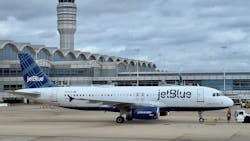American-JetBlue Antitrust Trial Testing Limits of Industry Consolidation
American Airlines CEO Robert Isom told a federal judge Monday that the carrier was hindered in markets like New York and Boston because of the headstart that Delta and others had as blockbuster mergers shrunk the industry over the last two decades.
Isom, who testified in the Justice Department’s antitrust trial against a partnership between American Airlines and JetBlue, used the argument to defend against the federal government’s allegations of colluding to raise prices and reduce competition in the Northeast.
It’s a chicken-and-egg argument that airlines have used for more than two decades to justify mergers.
“Delta has done a really nice job of running a network airline and, based on my assessment, they actually accomplished their merger with Northwest probably five years, six years prior to ours,” Isom said. “ Delta and Northwest created the largest airline in the world and with their network and with their partnerships, they could offer many, many more origins and destinations that could appeal to customers that were no frills all the way up to the most premium.”
The Biden administration has attacked consolidation in the airline industry and used the American Airlines-JetBlue Northeast Alliance as its first legal challenge to what the White House says is anti-consumer behavior. The case could have big implications with potential mergers in the future, including the pending marriage between Spirit and JetBlue Airlines.
Justice Department lawyers are arguing against an alliance between the nation’s first and sixth largest carriers, while those same carriers are arguing that they need partnerships such as these to compete against previous mergers.
Delta merged with Northwest Airlines in 2008. United merged with Continental in 2010 and Dallas-based Southwest acquired AirTran in 2011. American Airlines merged with US Airways in 2013.
The question now is “How much consolidation is too much?” The four largest airlines carry two-thirds of all passengers in the U.S, according to Department of Transportation figures.
The case is particularly tricky because it involves coordinating routes and schedules in heavily contested airports such as JFK and LaGuardia in New York and Boston’s Logan International Airport. On Friday, United Airlines announced that it would suspend service at JFK while it negotiates with the Federal Aviation Administration for more slots there.
American has the third most slots at JFK, behind Delta and JetBlue.
“American has a slot portfolio, basically round trips” that total 105 at JFK and 163 at LaGuardia,” said Isom, who was president of American Airlines at the time the alliance was created. “And while it sounds like a lot of flights, in the scheme of things, it’s not when you’re going up against competitors [at JFK] where Delta would have double the number of flights.”
He said American also has 50% fewer slots at LaGuardia, the New York City airport primarily serving domestic traffic.
“It puts us at a great disadvantage and there’s really not much that you can do other than utilize what you have there as best as possible,” Isom said.
U.S District Judge Leo Sorokin, who is hearing the trial in Boston without a jury, listened to testimony Monday from Isom and Scott Laurence, a senior American Airlines network planning executive who recently worked for both JetBlue and Delta Air Lines.
Government lawyers focused Monday on a March 29, 2020, email from Isom to American Airlines network scheduling chief Vasu Raja, talking about the possibility of industry-wide reductions in capacity in the ensuing 18 months.
Isom said the email focused on the impact of the COVID-19 pandemic, which was quickly forcing airlines to cancel thousands of flights across the industry. American announced its alliance with JetBlue three months later while the industry was still in turmoil.
“We were in the midst of the largest crisis that I’d ever seen in the airline industry, one that was potentially threatening the viability of American and every day that we waited, we were losing out on tens of millions, if not hundreds of millions,” Isom said. “On a given day, we only had $7 billion or $8 billion of cash on hand and projections were such that we could run out of cash and become insolvent in a fairly short period of time.”
------
©2022 The Dallas Morning News. Distributed by Tribune Content Agency, LLC.
